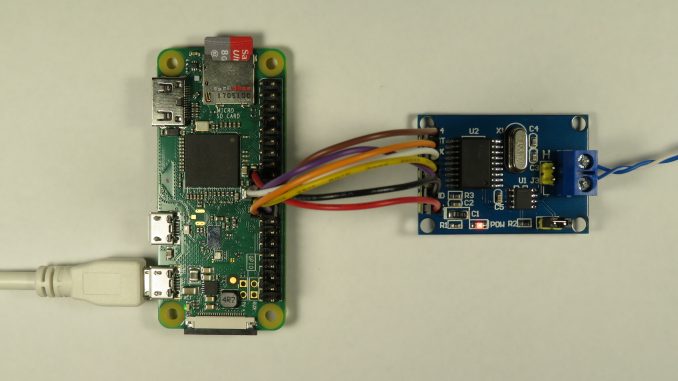
The CAN bus (Controller Area Network) was originally designed by Bosch for the automotive market to connect ECUs (Engine/Electronic Control Units) together. Today, this robust communications bus is commonly found, not only in vehicles, but also on the factory floor in automation (e.g. CANOpen) and other applications such as PV solar inverter/battery Energy Storage Systems (ESS).
The Raspberry PI doesn’t natively support CAN. The Broadcom SoCs (System on a Chip) used by the Raspberry PI doesn’t include a CAN controller.
The Linux kernel supports CAN and includes SocketCAN drivers for the Microchip MCP2515 Stand-alone CAN Controller with SPI Interface. Various add-on expansion boards (‘hats’) exist for the Raspberry PI including:
- PiCAN2, PiCAN3 and other variants from SK Pang Electronics
- RS485 CAN HAT from Waveshare International Limited
- 2-Channel Isolated CAN FD Expansion Hat from Waveshare
- MCP2515 CAN Bus Module Board TJA1050 from Aliexpress, Banggood and ebay.
MCP2515 CAN Bus Module Board with TJA1050 SN65HVD230
While this module is dirt cheap and extremely prevalent, it is not 3.3V compatible and hence Raspberry PI compatible. This board is designed to work from 5V only.
The on-board Microchip MCP2515 CAN Controller supports a wide voltage range from 2.7 to 5.5V. However, the CAN Transceiver, the TJA1050 from NXP only supports 4.75 to 5.25V.
One solution would be to power the board from 3.3V and cut the tracks on the PCB to power the TJA1050 from 5V. If you want to take this path, you can find instructions here.
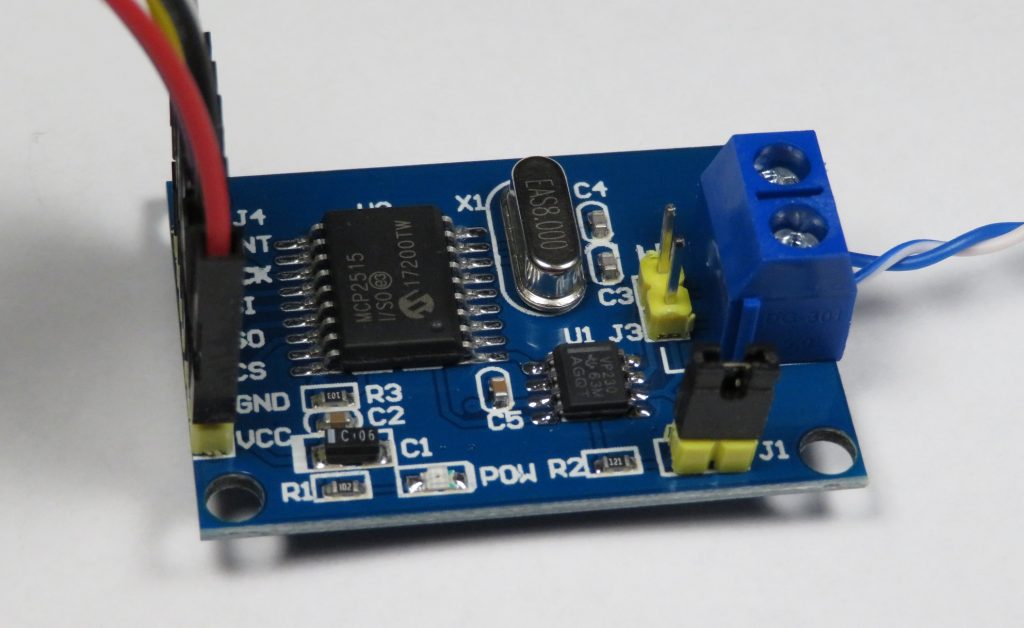
Alternatively, if you are proficient at SMD rework, you can remove the 5V CAN Transceiver and install a 3.3V version. I did this and opted to replace the 5V TJA1050 with the 3.3V SN65HVD230.
Wiring
Below is the recommended wiring configuration to connect the MCP2515 CAN Bus Module Board to the Raspberry PI’s 40 pin connector.
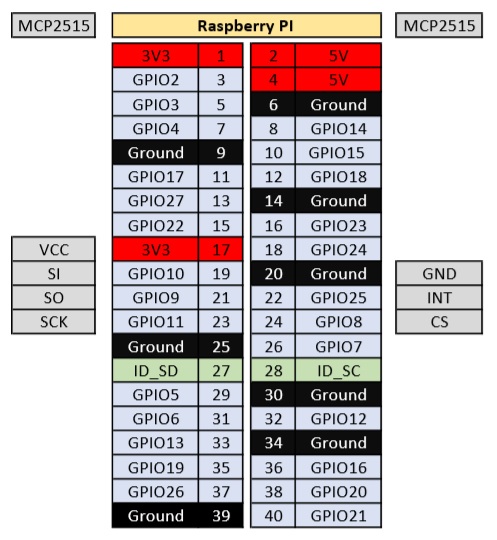
Driver Installation
Without an ID EEPROM on the ‘hat’ specifying the hardware, the Linux kernel will not automatically discover the CAN Controller on the SPI interface. To load the appropriate driver, you must specify device tree overlay settings at boot.
Add the following line to your /boot/config.txt file:
dtoverlay=mcp2515-can0,oscillator=8000000,interrupt=25
The oscillator parameter should be set to the actual crystal frequency found on your MCP2515. This frequency can change between modules, and is commonly either 16 or 8 MHz. My MCP2515 CAN Bus module board has a 8MHz on-board crystal and hence, I set the above line to 8000000.
The interrupt parameter specifies the Raspberry PI GPIO pin number. We have connected the INT pin to GPIO25.
By default, the mcp2515 driver uses a maximum SPI frequency of 10MHz (as per the MCP2515 datasheet). You can also specify the overlay an optional parameter spimaxfrequency, e.g. spimaxfrequency=2000000 to slow down the SPI clock to help with signal integrity issues – e.g. if you have flying leads, rather than a PCB!
Note: Historic documentation may suggest adding dtparam=spi=on and dtoverlay=spi-bcm2835-overlay. While the SPI master is not enabled by default, and specifying dtparam=spi=on will enable it, so will the mcp2515-can0 overlay. The spi-bcm2835-overlay was used to specify a newer bcm2835 SPI driver (vs the older bcm2708), but since version 4.4 of the kernel, bcm2835 is now the default driver.
Now reboot your PI. You should see the following kernel messages on boot:
[ 20.248951] CAN device driver interface
[ 20.499256] mcp251x spi0.0 can0: MCP2515 successfully initialized.
Naturally, if you see “Cannot initialize MCP2515. Wrong wiring?“, check the power and wiring of your CAN controller.
Once you have rebooted and the driver has been successfully loaded, you can manually bring up the CAN interface using:
sudo /sbin/ip link set can0 up type can bitrate 500000
The bitrate here is specified as 500kHz, but this may be changed to suit other devices on your CAN bus.
To automatically bring up the interface on boot, edit your /etc/network/interfaces file and add the following:
auto can0
iface can0 inet manual
pre-up /sbin/ip link set can0 type can bitrate 500000 triple-sampling on restart-ms 100
up /sbin/ifconfig can0 up
down /sbin/ifconfig can0 downThe SocketCAN interface behaves just like a network interface. You should be able to get various statistics using ifconfig (interface configuration)
pi@raspberrypi:~ $ ifconfig
can0: flags=193 mtu 16
unspec 00-00-00-00-00-00-00-00-00-00-00-00-00-00-00-00 txqueuelen 10 (UNSPEC)
RX packets 0 bytes 0 (0.0 B)
RX errors 0 dropped 0 overruns 0 frame 0
TX packets 0 bytes 0 (0.0 B)
TX errors 0 dropped 0 overruns 0 carrier 0 collisions 0
CAN-utils
CAN-utils is a collection of extremely useful debugging tools using the SocketCAN interface. It includes applications such as:
- candump – Dump can packets – display, filter and log to disk.
- canplayer – Replay CAN log files.
- cansend – Send a single frame.
- cangen – Generate random traffic.
- canbusload – display the current CAN bus utilisation.
CAN-utils source can be obtained from the GitHub repository: https://github.com/linux-can/can-utils
Alternatively, pre-compiled binaries can be installed using:
sudo apt-get install can-utils
Code Development
Check out our tutorial for example C SocketCAN code.
Performance
On buses which high frame rates, the mcp251x driver may struggle. It is not unusual to see the irq/160-mcp251x kernel process using 25 percent of the CPU and the spi0 kernel using another 10 percent.
Enabling DMA doesn’t seem to make a material difference.
For most applications, it is unlikely you will want to capture and process every CAN frame. More likely than not, you are only only after frames sent to a specific address or range of addresses. This is how CAN buses were envisioned.
Given any other CAN device, one would just set a CAN filter and mask. This would filter out any frames not of interest and leave the firmware/software to deal with the important frames.
While this can be done, one of the deficiencies of the SocketCAN interface is that this filtering happens at a kernel module level. The filter and mask is never passed to the mcp251x for hardware level filtering. As a result, high CPU utilisation is still present when using filtering.
mcp251x.ko driver with hardware level filtering
One solution would be to modify the mcp251x driver to enable hardware filtering. Currently no means of passing down the filter or mask exists, but it could be either hardcoded, or loaded in at module load.
If this is of interest, see https://github.com/craigpeacock/mcp251x
If high frame rates are required, you may be better off to switch to alternative embedded Linux platforms such as the BeagleBone. The BeagleBone has internal CAN Controllers and support high frame rates with ease.

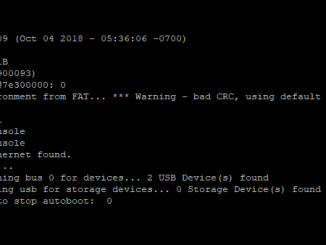
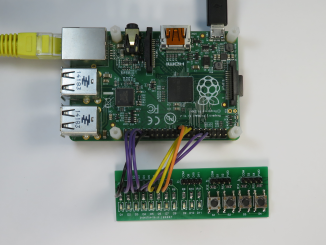
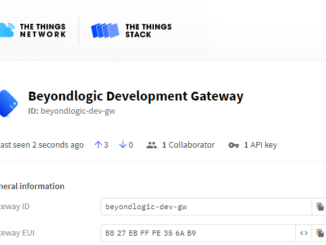
This is excellent. Thanks for taking the time to sort it out.
I have done all steps following this article,and no error occcur,when i write data using cansend ,everything is well,but i can receive noting on my can board. Do you know how to make it works?
I am running this board with the original TJA1050 chip, connected to he +5V pin in the Pi version 3B. Pi is powered by an external battery bank with 5V @ 2A. It works fine
Hi Rajan, could you please explain how you connected the Raspberry Pi to the MCP2515 with the TJA1050 chip?
Thanks in advance
“Robert Bosch” is not the name of the company but of the person, its founder. The company he founded is commonly named “Bosch” and (nowadays, after several changes) officially registered as “Robert Bosch GmbH”. If you write that CAN “was originally designed by Robert Bosch”, that would mean that Robert Bosch himself invented CAN in person. He died around 40 years before the CAN protocol was invented within the company he founded.
I was thinking the same when I read it.
So funny to find a comment from the same day.
Thanks Guys. I’ve changed it to just Bosch. Naturally, I was referring to the company, hence why it was hyperlinked to the Robert Bosch GmbH Corporate Website.
about SocketCAN’s lack of support for hardware-based acceptance filtering: what about using can4linux as an alternative? as far as what I can quickly find e.g. the comment at CAN_IOCTL_CONFIG at http://www.can-wiki.info/can4linux/man/ioctl_8c.html, it seems that it’s just the opposite case of SocketCAN i.e. that it supports hardware acceptance filtering but not software-based filtering.
Raspberry pi 4
if can module connected to by both 3.3v and 5v – raspbery pi would not boot.
if disconnect any it will boot fine. and can will work fine once you plug in both after boot. Any ideas?
I have the same problem with my RPi 4.
Somebody as a solution?
I had the same problem and gave up, finally replaced the driver with a 3.3v chip.
Did you find the solution for this? … I’m getting the same with mcp2515/tja2050 or mcp2515/mcp2551 where mcp2551 is powered by 3.3V from rpi and can driver from rpi 5V pins.
If someone else has problems getting the communication working try to change dtoverlay part to this:
dtoverlay=mcp2515-can0,interrupt=25
This setup worked fine in the past month. But now there is no can0 device anymore after updating my raspberry with sudo apt update /upgrade. Do you have any solution?
Hello, I managed to configure SPI0 as stated but I cannot configure SPI1. It’s just not showing it even with the command dtoverlay=spi1-1sc. What I want to achieve is to have 2 MCP2515 to use 2 can channels both configured at the same time.
Hi Craig, thanks for the excellent write-up. I was trying to use the HW-level filtering driver with MCP2518 can-fd controller and it’s not included. Any chances to have it updated for the MCP2518FD too?
Hi Craig! Great write up. I too have been working with this same CAN device and a Pi4. I also replaced the CAN Transceiver with a 3.3v version. Everything works great, but I have one problem that I cannot figure out. With the CAN interface added to /etc/network/interfaces the Pi has trouble doing a reboot. It seems to get stuck. If I wait a LONG time it seems to eventually reboot, like 10 or 20 minutes, I never timed it. I can do a sudo reboot -f and force it to reboot ok. But I cannot figure out what or why it is getting stuck. I’ve verified it the interface that’s creating the issue, because if I leave it out and never start it manually it reboots without a hitch. I’m running the latest build and EEPROM on my Pi4. Any ideas???
Thanks – George
Sorry George, It’s not something I have seen. Maybe someone else can help.
Hey,
i have problem with pican 3 it works only in listen mode:(
Thank you very much, Craig. I was able to set it up, but I had to reset the mcp2515 first, via it’s reset pin connected to a Pi-gpio pin. Are there more options, you can pass to the kernel-module? I want to enable the clock-output, as seen in the datasheet of the mcp2515, CNF3 register. If this is not possible by kernel-module-parameter, how to do it then?
Best regards,
Simon
PS: I don’t use that PCBs, I’ve built it up on a breadboard.
How to connect sensors like thermistor to the CAN Bus? Do you have any products which can be used?
Hello,
i’m using rpi4 and i have a problem with PmodCan(mcp2515).
the board is seccussfully initialized ([ 6.905542] mcp251x spi0.0 can0: MCP2515 successfully initialized.) but if i use the commande “sudo ip link set can0 up type can bitrate 500000” the rpi pass to block status and i can’t use other command the only solution is to shutdown the rpi. any ideas?
thanks a lot